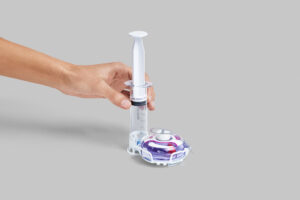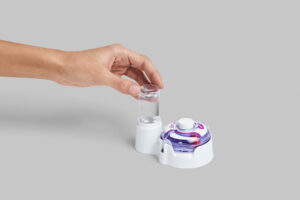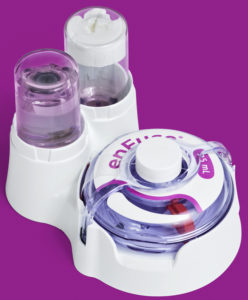
A New Frontier: Self-Administration of Lyophilized, Large-Volume Subcutaneous Biologics
From ONdrugDelivery September 2023:
Biologics are the mainstay of therapy for a growing number of diseases, as they can provide more effective and targeted treatment than traditional therapies. These drugs are often composed of living organisms or their by-products. The most common format for a biologic drug is a monoclonal antibody (mAb). Biologics, specifically mAbs, can be bioengineered to improve the safety, efficacy, half-life, potency and other characteristics of therapies, which makes them particularly attractive to drug developers.
“
Since the approval of the first biologic in 1986, the number of biologic drug approvals and submissions has increased steadily. Antibody drugs have taken the spotlight with a steady growth in approvals over the decades in both intravenous (IV) and subcutaneous (SC) formats. A review by Strickley and Lambert published in 2021 shows that, of the 136 antibodies identified, 47 were SC (34.5%), 85 were IV (62.5%) and the remainder used other delivery routes (3%). The review highlighted that 100 were a liquid solution (73.5%) and 36 were lyophilised (26.5%).
LYOPHILISATION – PROS AND CONS
Over a quarter of all mAbs are lyophilised, which is likely due to stability challenges. Similarly, many peptides are also lyophilised due to their high sensitivity to temperature and shear forces. For example, in antibody-drug conjugates (ADCs), the linker is usually a peptide, so in order to minimise the instability associated with the linker, all US FDA-approved ADCs are lyophilised. Given the complexity of mAbs and their sensitivity to changes, bioengineering to improve mAb characteristics can often come with physical stability challenges.
mAb drugs are susceptible to conformational changes, protein aggregation and other stability issues. These issues can be caused by changes in temperature, the addition of certain excipients and buffers and other factors. These obstacles are exacerbated when trying to create a highly concentrated format, since protein aggregation is concentration dependent. Trying to develop a high-concentration, low-volume mAb formulation for SC injection is possible; however, it can be time- and labour-intensive, which can delay the clinical trial timeline. If a high-concentration liquid formulation is successfully designed for all characteristics except aggregation, then lyophilisation may be the best approach.
In addition to its benefits on the formulation process, lyophilisation can also simplify shipping and handling of drugs by eliminating the need for cold chain storage and reducing the weight and volume of the drug. Since lyophilisation removes water from the product, it can also increase the shelf life of drugs as the lack of water creates a challenging environment for microbial growth and chemical reactions.
However, while lyophilisation can solve stability issues, it can have negative downstream implications pertaining to patient preference, drug wastage, delivery device selection (if SC delivery is desired) and human risk factors. The need for a diluent for a lyophilised drug adds complexity and the reconstitution process introduces increased time requirements and the potential for human error into the process, which is especially impactful if patient self-administration is the goal. This additional step makes delivering lyophilised drugs with standard syringes and autoinjectors challenging for self-administration.
This leads manufacturers to options that limit SC delivery volumes (<5 mL), such as complex dual-chamber syringes. Because these dual-chamber syringes use a new storage container for the drug, changing away from the original vial, the developer must go through primary container testing.5 In other words, because the drug is now being stored in the syringe chamber and not in the vial, additional work must be done on the new container, which is cost- and time-intensive.
“The enFuse DVT system is designed to provide a simpler solution to the reconstitution step, which is the largest source of error among patients self-administering lyophilised drugs.”
LARGE-VOLUME SC FORMULATIONS
While lyophilisation of high-concentration formulations is a viable strategy to reduce the risk of aggregation, aggregation risk may also be mitigated by reducing the concentration and increasing the volume of the formulation. Reducing concentration and increasing volume would typically result in a drug formulation in the 5–25 mL range. There is a common, unsubstantiated belief that volumes this high cannot be administered subcutaneously without a permeation enhancer. However, large-volume SC biologic drugs, such as SC immunoglobulin (25 mL per site on the abdomen), and evolocumab (3.5 mL) were approved and successfully administered for years prior to the introduction of permeation enhancers.
In recent years, multiple large-volume SC drugs have been approved and are successfully administered without a permeation enhancer, including pegcetocoplan (20 mL), ravulizumab (7 mL), rozanolixizumab (3–6 mL), and others still in development. While permeation enhancers may increase absorption, they have not demonstrated a significant impact on bioavailability in prospective human trials. Delivering these drugs via a syringe, in combination with hyaluronidase, does not allow for patient self-administration and has led to musculoskeletal issues in nurses after repeated administration.
When considering the large volume of 5–25 mL in the context of patient self-administration, only two delivery options exist: Enable Injections’ enFuse® or a SC syringe pump. enFuse is the first purely mechanical on-body delivery system with an original container closure and flexible dosing capability and, in a recent study, enFuse demonstrated unanimous patient preference in all surveyed patients versus a SC syringe pump. Patients stated their outstanding preference for the enFuse was due to ease-of-use, increased mobility during infusion, reduced setup time and reduced pain at the injection site. If lyophilisation is necessary for the structure of the drug, or if the other benefits of lyophilisation are desired, the enFuse has multiple modalities that are designed to enable self-administration of lyophilised large-volume SC biologics.
RECONSTITUTION WITH CURRENT ENFUSE TECHNOLOGY

The enFuse system consists of an on-body delivery device coupled to a transfer system, provided to the end user in sterile packaging. The enFuse transfer systems currently consist of a syringe transfer (ST) system and a vial transfer (VT) system. Additionally, a dual vial transfer (DVT) system is currently in development to support other large-volume SC applications, including lyophilised biologics. The ST system uses a prefilled syringe or a user-filled syringe to transfer the drug product into the enFuse. The user presses down on the syringe to initiate the transfer.
In contrast, the VT system has the user insert a single vial into the system, after which the drug product is automatically transferred into the enFuse. This provides optionality, as manufacturers can choose the system that best suits the needs of their patient population. Both systems can be used for self-administration of lyophilised drug products.

The lyophilised drug product would be reconstituted according to the drug product’s instructions for use. Once reconstituted, the drug product would be transferred to the enFuse using the appropriate system. The ST system is used for drugs reconstituted in a syringe, while the VT system is used for drugs reconstituted in a vial. No changes to the original container closure or additional preparation steps are required aside from insertion into the transfer device. Leveraging the enFuse system for delivery of SC lyophilised drugs offers several benefits, including ease-of-use, a hidden needle and hands-free delivery, designed to allow patients to perform light-to-moderate activities during injection.
THE FUTURE – THE ENFUSE DUAL VIAL TRANSFER SYSTEM
As more and more therapies move away from the clinic to lower cost sites of care (home infusion or self-administration), innovations in drug delivery need to incorporate designs that allow self-administration at home by the patient. The novel enFuse DVT system focuses on this for lyophilised drug products with large SC drug volumes. The enFuse DVT system is designed to provide a simpler solution to the reconstitution step, which is the largest source of error among patients self-administering lyophilised drugs. During the reconstitution step, patients are often confused by the number of steps and supplies, which contributes to instructions for use deviations a nd sterility breaches.
nd sterility breaches.
The enFuse DVT system is designed to simplify the process, such that the user feels comfortable preparing and administering their own therapies with confidence. The enFuse DVT system incorporates the same philosophy of administration as the enFuse VT system, but includes two vial insertion points. In the case of a lyophilised drug, one vial slot would include the lyophilised drug product and the other vial slot would include the diluent. Once filling is complete, the user removes the enFuse delivery device from the transfer base, places it on the abdomen and presses the button to begin SC delivery.
Lyophilised drugs require reconstitution at the time of use, adding additional preparation steps and complexity for the user; however, by using the enFuse DVT system, the process of reconstitution and administration can be simplified.
